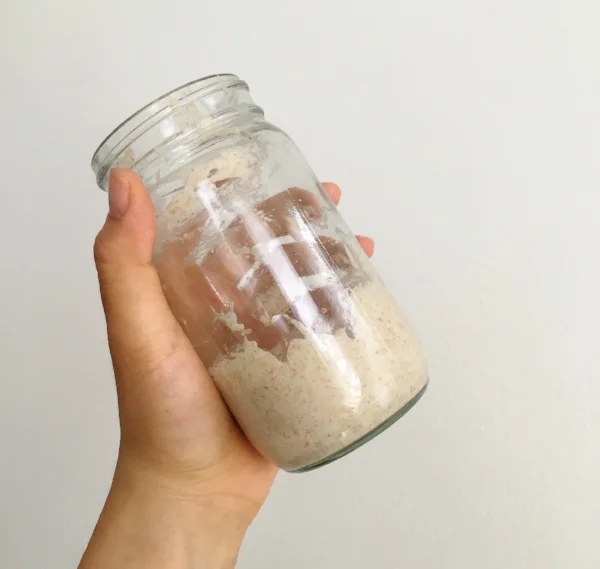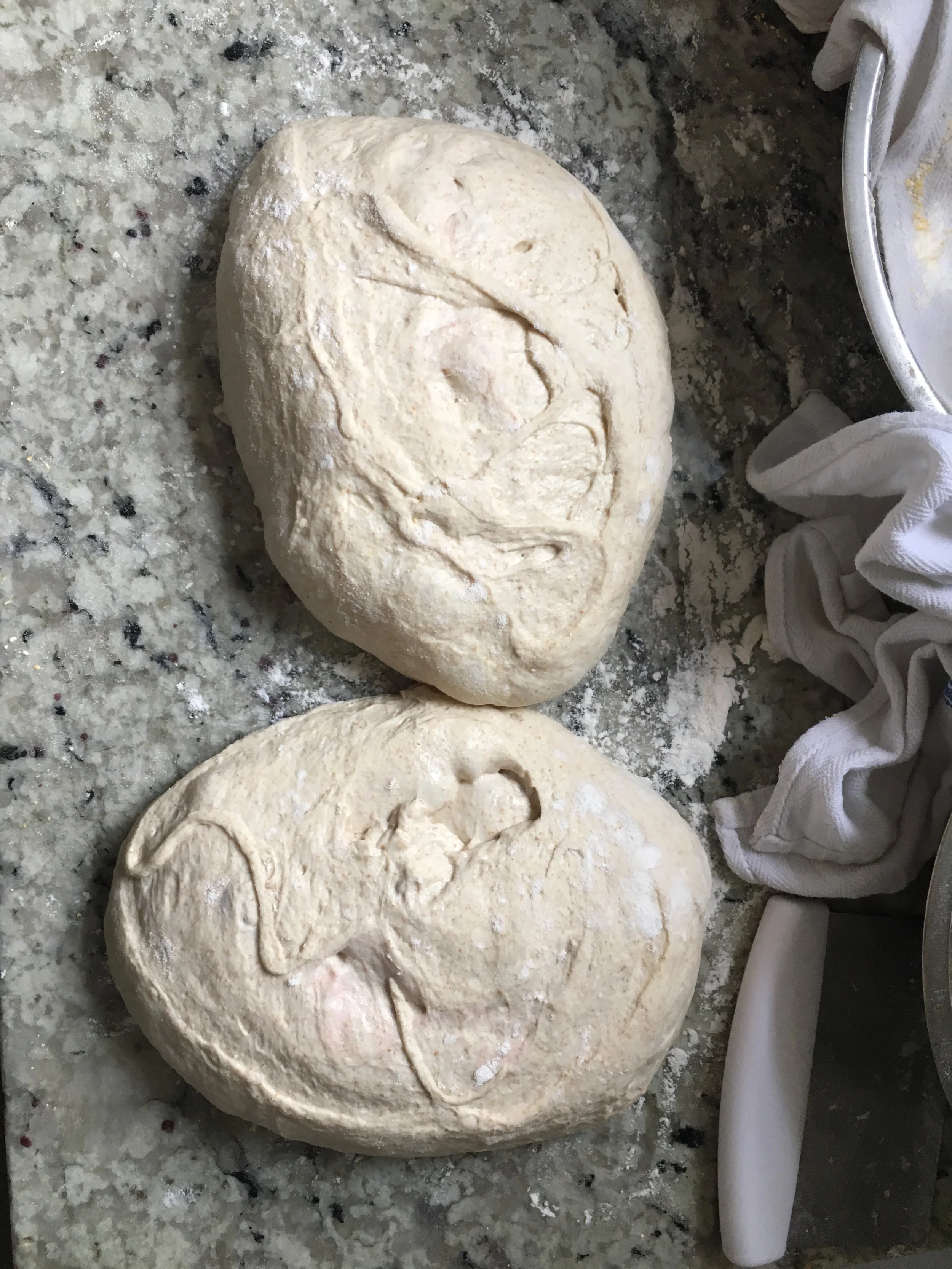Sourdough Bread
Author & Photographer: Anna Li
As amateur and professional bread bakers alike will tell you, making bread is much more a process than it is a recipe. Bread, in the classic “artisan” sense (think crusty loaves in the window of a French boulangerie or the supporting actor of your $14 avocado toast brunch entrée), is composed of nothing more than flour, water, salt, and yeast. Together, they will eventually develop enough strength, gas, and flavor to produce a wonderful loaf of bread.
Bread starts with four ingredients, but there is enormous room for variation and unpredictability with each ingredient and at every step of the process. You could make a low-hydration dough with a dense texture and fine crumb (the hole pattern of a slice of bread), a high-hydration dough with a large, elastic structure, or a high-hydration dough that ends up dense anyway. For the flour, you can choose from all-purpose, bread flour, whole wheat, rye, spelt, semolina, or any combination of the above.
But even after you’ve settled on a certain kind of flour and its ratio to water, you then have to account for the yeast – the ingredient that gives bread the all-important height and rise. Without it, bread would just be a very, very dense loaf of cooked flour. Yum. Yeast is a living organism, and – like other living organisms I know (read: humans) – it is temperamental, difficult to predict, and very sensitive. Its activity will change depending on the temperature of the room and other ingredients, the amount of salt, and, for all I know, what phase the moon is in.
But why not add another wildcard to the mix?
Meet Chloé, my sourdough starter–the mass of fermented water and flour that serves as the base for truly special and flavorful baked goods.
I like to think she was a Kardashian in a past life–high maintenance, dramatic, and hardworking enough to deserve a lifestyle-brand empire of her own. It’s been nearly four months of parenthood so far, beginning with 10 days of daily feedings of flour and water until the wild yeast from the flour and surrounding environment became strong enough to be used for baking bread.
When you feed a starter, there’s a huge uptick in activity where it’ll produce a ton of bubbles and double in size before shrinking down again. When the starter stops bubbling, it doesn’t mean activity has stopped; rather, the activity has shifted from aerobic to anaerobic activity–the latter stage producing sharper acidic flavors. The goal is to use the starter at the select phase in this cycle, so it can then receive another “feeding” and burst of activity when you add it to your dough. The variables here are endless; the type of flour you feed your starter, the ratio of the flour to water in the feeding, the temperature, and the amount of time between feedings will all subtly affect the yeast culture that will give flavor and rise to your final product. You can read all about sourdough starters here.
Then, you add in the process: autolyse, mixing, folding, fermenting, pre-shape, bench rest, shaping, proofing, and finally, baking.
While yeast produces gas and flavor, the bread needs to develop enough strength where it can capture and maintain those bubbles (which become the holes in a bread’s “crumb”). With artisan breads, big, irregular holes are desirable – a style made hugely popular by Chad Robertson at Tartine Bakery. This is one of the hallmarks of well-developed bread and a skilled baker, and is made possible by the hydration and subsequent stretching of gluten in flour. You can build strength with periodic folds (my preferred method), the “slap & fold,” Rubaud mixing, or traditional kneading. Time alone will also let gluten networks build–this is the secret of “no-knead” bread recipes. Too little strength and the bread will be flat and dense. On the other hand, spending too much time or effort on working gluten can push the gas out or produce overly sour, unappetizing bread.
Making bread is the culminate of the tricky balance between yeast activity and gas production and the slow development of elasticity and strength in the bread. In May, I decided that I had done enough studying of the infinite amount of variables and that practice would be the best next step.
I followed the recipe and ratio for Tartine’s Country Loaf, and have made 30+ loaves with this recipe since. Every batch, even when I used identical ingredients and timing, has turned out differently. This is, of course, what every ENTP Gemini Type-A Control Freak loves to see. My first loaf had a crumb that was wildly uneven, with dense tiny bubbles near the bottom of the bread and giant ones ballooning towards the top of the loaf. My second round was much more even, but still less open than I desired. Despite the spectrum of results, I’ve never had a batch that tasted bad – I have Chloé to thank for that.
My older brother has made upwards of 100 loaves of Tartine’s Country Loaf, and he still struggles with consistency and getting the crumb structure that shows up on my Instagram feed to taunt my amateurish-by-comparison loaves. We’re not alone. Emily Spurlin, pastry chef at Chicago’s Bad Hunter, posted a picture of her own work-in-progress sourdough on Instagram, saying “It’s hard learning to bake sourdough in the age of Instagram. The opportunity for harmful comparison is endless… I’m trying to let go of the aesthetics and instead just enjoy the process.” Ironically, I had been jealous of her quick progress, even crumb structures, and use of local, specialty flours. Still, like Spurlin, I’ve found making sourdough bread a process that is easy to love.
As someone who is quick to force a sense of structure and predictability into every aspect of my life, making bread allows me to surrender to a process and accept the universe of factors I can’t control so I can focus on the aspects I can. Sometimes, that means coming back from the club at 2AM to militantly shape loaves and put them in the fridge for an overnight rise. Other times, that means staying at the club and forgetting about the dough until morning and discovering that a longer bulk ferment results in stronger, more elastic loaves.
Moral of the story? Baking bread is black magic; science is dead. Bread is more than flour, water, salt, yeast–it’s part science, part enigmatic amalgamation of the time, temperature, touch of its making and the blood, sweat, and tears of its maker. It requires practice–endless practice–and a willingness to enjoy the labor in and of itself. More important than trying to attain some elusive standard, this overzealous bread-baking hobby convinced me to start a food-giveaway listhost (add yourself!) that allows me to indulge my favorite part about baking: sharing and feeding other people. It’s a healthy reminder that–no matter how much I obsess over the sourdough making process–at the end of the day, bread is bread, and bread is at its best served with olive oil and good company.
If you want to learn more about “artisan” bread making, check out Ken Forkish’s “Flour Water Salt Yeast” or The Perfect Loaf.
Interested in giving it a try yourself? Shoot me an email (annazfli@uchicago.edu) and I’ll give you some starter to feed, name, and take care of, so you too can join me on the long journey to beautiful bread.



